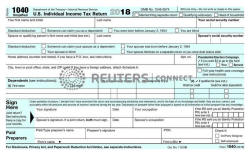Your Money: The IRS Form 1040 looks different, in more
ways than one
 Send a link to a friend
Send a link to a friend
 [February 12, 2019] By
Beth Pinsker [February 12, 2019] By
Beth Pinsker
NEW YORK (Reuters) - While this year's
taxapalooza is off to a slow start because of the earlier U.S.
government shutdown, one thing already is clear: your refund might be a
whole lot smaller than you were expecting.
The Internal Revenue Service (IRS) released its first set of filing
season statistics last week. The average refund was down 8.4 percent
from the equivalent period last year, at $1,865 from $2,035.
The lower refund amount is tied up in changes from the Tax Cuts and Jobs
Act that went into effect in 2018. To match the new law, the government
last year changed the amount of tax withholding it takes out of
paychecks.
Yet many people did not notice and adjust their withholding. So when it
comes to tax time, filers may be getting back less - even if their
overall tax burden was lower than the previous year.
Not everyone should expect smaller refunds. Some may get worse news, and
actually end up owing, particularly single taxpayers in states with high
local taxes.

Tynisa Gaines, an enrolled agent tax preparer based in Henrico,
Virginia, has a single client who is going to owe more this year in
taxes, even though he is now in a lower tax bracket. This is because he
can no longer deduct as much of his state and local taxes, which results
in a difference of about $5,000 more in taxable income for 2018.
"He's going to be mad," Gaines said. "I haven't told him yet."
HIDDEN TEXT
One big change that will make refunds look different is the tax form
itself. Filers used to skipping straight to line 76 to make sure their
refund is correct can now find that information on line 19.
The new cosmetic look of the 1040 form belies all the changes within.
The redesign squishes what used to be 79 lines of information into just
22, on two half-sheets of paper.
But things did not get streamlined and simplified. All of those missing
lines now correspond to six new numbered schedules and several
worksheets. And that is in addition to the existing alphabetical
schedules (A for itemizing deductions, B for interest and dividends,
etc.)
"It's not a postcard, you can't mail it. It's maddening," said Jerry
Gaddis, an enrolled agent tax preparer based in Winter Haven, Florida.
If you are an Uber driver, for example, you used to have a simple
return, with just a Schedule C for business income. This kind of return
is now the most complicated, said Gaines, who is seeing 15 more pages
per return, on average.
[to top of second column] |

The new Form 1040 tax
form for individuals, released by U.S. Treasury Department, is shown
in this handout image obtained June 29, 2018. Department of the
Treasury/Handout via REUTERS/File Photo

You need several new additional schedules and worksheets to figure out the new
20 percent deduction for qualified business income, she added.
Phyllis Jo Kubey, an enrolled agent in New York, has basically given up trying
to process the changes visually. Her tax software even comes with a "1040
reconciliation worksheet," which takes everything on this year's tax form and
makes it look like an old 1040.
"Itís easier for me to find things on the old form than to look at six different
schedules," Kubey said.
Kubey is especially concerned for senior citizens, who might be among the last
of those who fill out the 1040 by hand.
"Can you imagine if you have been doing taxes every year of your life on paper,
and then all the sudden you get this? I'd go nuts," Kubey said.
For taxpayers who file electronically, the new form might not have that much of
an impact. A professional tax preparer will take your information the same as
always and deal with the changes for you.
DIY tax software will prompt you for the information needed in a similar manner
to previous years, with just a few new questions.
It is when the results are printed out that most people will notice the
difference. Kubey decided to sidestep this by giving a copy of the old-style
version to her clients with the file copy of their return.
While Kubey wants them to understand the new tax system, she knows that they
will have trouble comparing this year to any past years if they cannot see the
information in a way that matches it up.

Gaddis is doing something similar for clients - his software creates a
three-year comparison in the old form's style.
"I don't even show them the new 1040," Gaddis said. "They wouldn't understand it
and I couldn't explain it."
(Editing by Lauren Young and G Crosse)
[© 2019 Thomson Reuters. All rights
reserved.] Copyright 2019 Reuters. All rights reserved. This material may not be published,
broadcast, rewritten or redistributed.
Thompson Reuters is solely responsible for this content. |